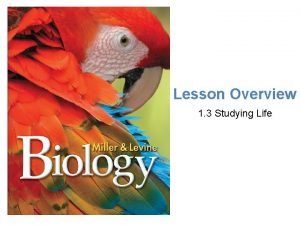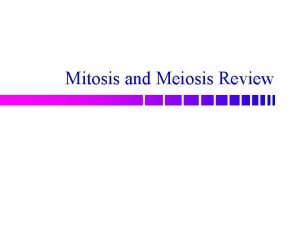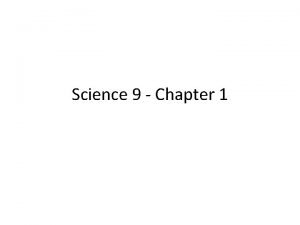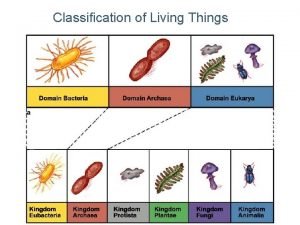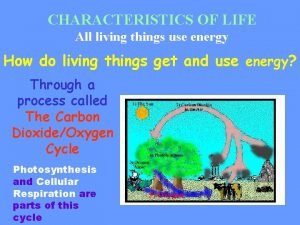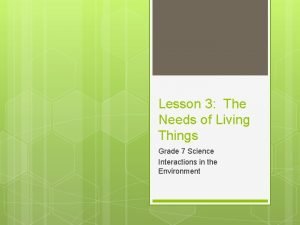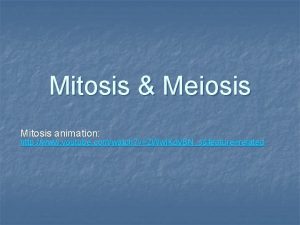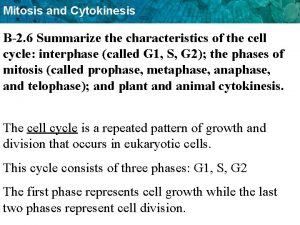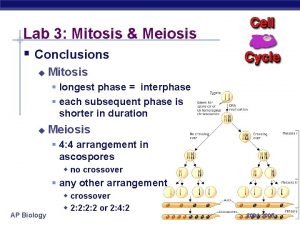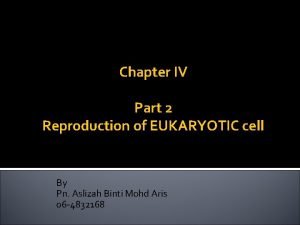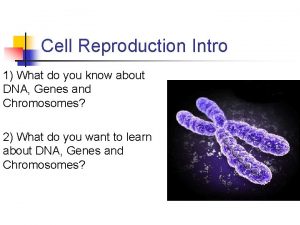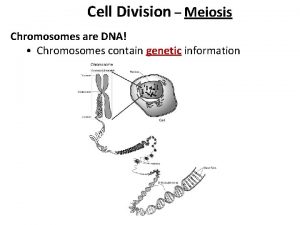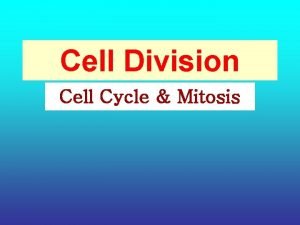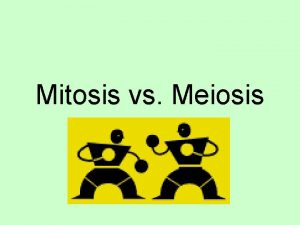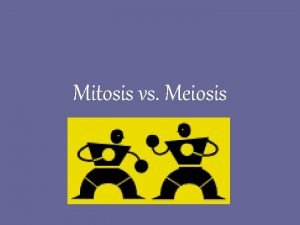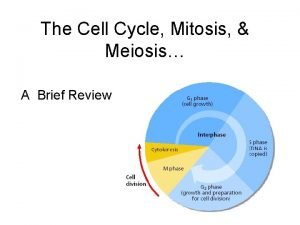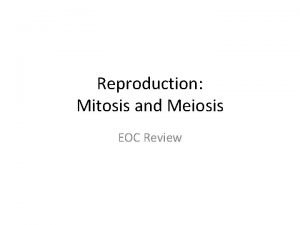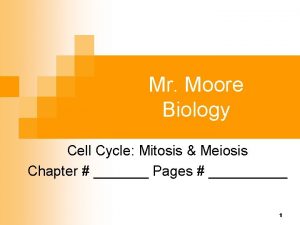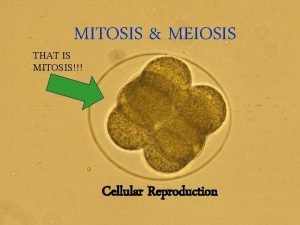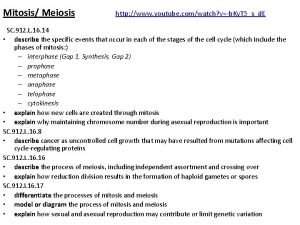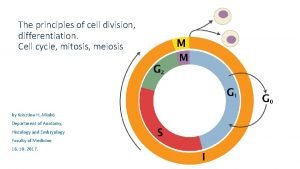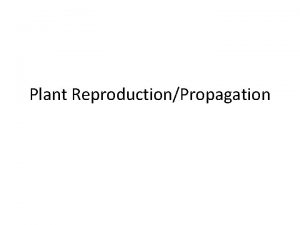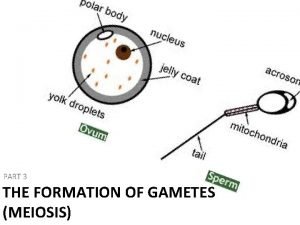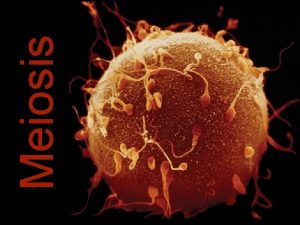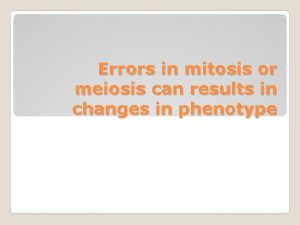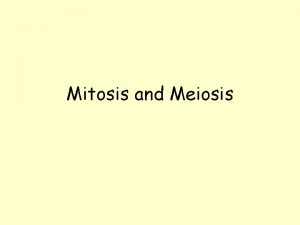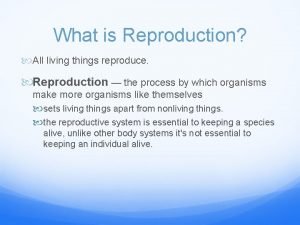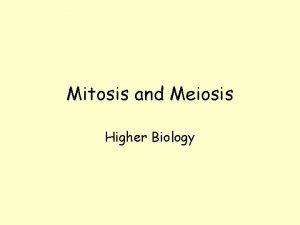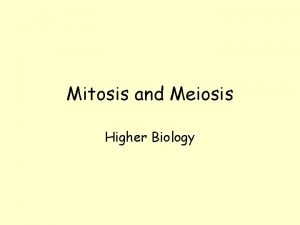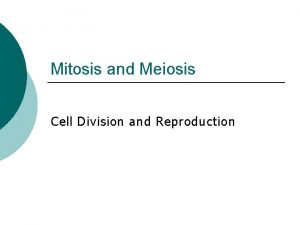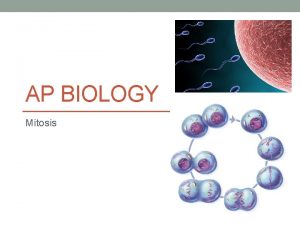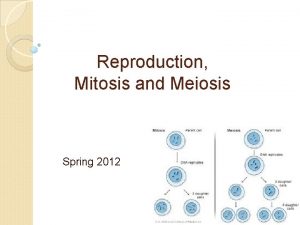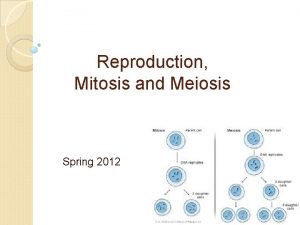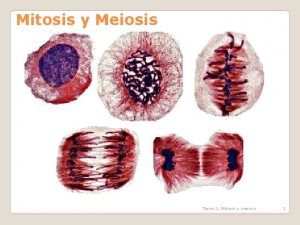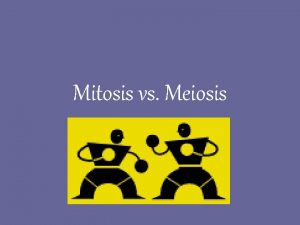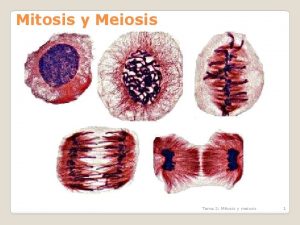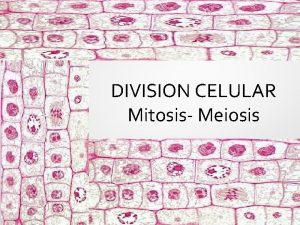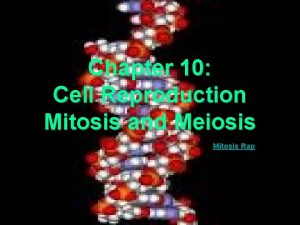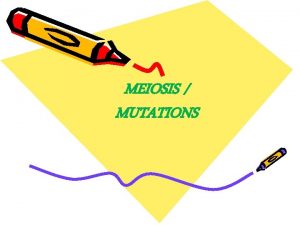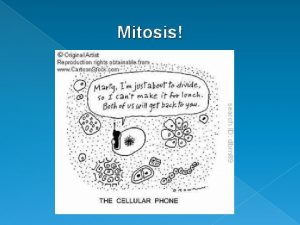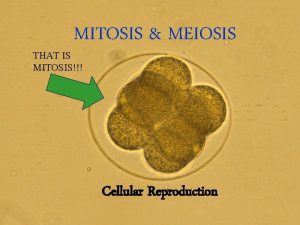Reproduction Mitosis and Meiosis All Living Things REPRODUCE





















































- Slides: 53

Reproduction, Mitosis and Meiosis

All Living Things REPRODUCE… Without reproduction all living things would go EXTINCT…

HOW DOES A LIVING ORGANISM REPRODUCE? Living things can reproduce in 2 different ways: SEXUALLY OR ASEXUALLY Similarities: Both types produce an offspring. Asexual reproduction - only one parent is needed for reproduction. Offspring is a clone (genetically the same) of parent. Sexual Reproduction – Two parents are needed for reproduction. Offspring is genetically different than parents.

5 Types of Asexual Reproduction Budding – occurs in simple multi– celled animals and unicellular fungi, a small individual grows off the body of the adult. KINGDOM : ANIMALS Hydra, jellyfish, corals, sea anemone. FUNGIyeast

5 Types of Asexual Reproduction Binary Fission – simple cell division. Most unicellular organisms like bacteria and protists reproduce this way. KINGDOMS: Protists and bacteria

5 Types of Asexual Reproduction Spores- Are reproductive cells that grow into new individuals when conditions are right. Some ferns and fungi reproduce this way. KINGDOM : Plants and Fungi

5 Types of Asexual Reproduction Regeneration/Fragmentation – Occurs in multi-cellular animals. Entire organisms grow from a piece of the adult. KINGDOM: ANIMALS EX: Worms and Starfish.

5 Types of Asexual Reproduction Vegetative Propagation – Cuttings from plants grow into new individuals, or new runners (root structures) are produced. KINGDOM: PLANT EX: Strawberry plants, monkey grass, potatoes.


SEXUAL REPRODUCTION Most multi-cellular organisms reproduce this way, including KINGDOMS ANIMAL, PLANT and FUNGI. Sexual reproduction involves two sex cells. One sex cell is needed from each parent. The sex cells, also called gametes, are egg cells in the female and sperm cells in the male.

SEXUAL REPRODUCTION: allows for variation. Sexual reproduction always involves the combining of 2 nuclei from 2 different sex cells. Fertilization is the joining of egg and sperm. The cell (fertilized egg) that comes from fertilization is called the ZYGOTE.

ADVANTAGES AND DISADVANTAGES OF ASEXUAL REPRODUCTION Advantages: 1. Quicker, no need to look for a mate. 2. Simpler to produce another just like yourself if you have desirable traits. Disadvantages: 1. No variation of traits, no individuality. 2. Offspring is a clone of the parent (can be bad if parent has undesirable traits.

ADVANTAGES AND DISADVANTAGES OF SEXUAL REPRODUCTION Advantage: 1. Allows for genetic variation. There will never be two just alike unless they are identical twins. v TWO different genetic codes from 2 different parents results in variation in a species. For example, no two quarter horses, pine trees, blue whales, dogwoods or humans are exactly alike. Disadvantages: 1. Takes more time (gestation). 2. More energy required to find a mate, etc.

CELL REPRODUCTION Mitosis and Meiosis

Chromosomes Definition: The structure that DNA is organized in. They come in pairs, half from each parent.

CHROMOSOME ARRANGEMENT All regular body cells have all the same # of chromosomes. There are 46 chromosomes in human body cells. Chromosomes always come in pairs. (Homologous Chromosomes) There are 46 chromosomes for a total of 23 pairs. 22 of the pairs are similar. The 23 rd pair is different. These are the sex chromosomes.

CHROMOSOME ARRANGEMENT HUMAN BODY CELLS HAVE 46 CHROMOSOMES OR 23 PAIRS. Nerve cell Bone cell BULLFROG BODY CELLS HAVE 26 CHROMOSOMES OR 13 PAIR. FRUIT FLY BODY CELLS HAVE 8 CHROMOSOMES OR 4 PAIR.

HOW DOES A CELL REPRODUCE ITSELF? The process is called CELL REPRODUCTION (DIVISION) Cell Reproduction Simple cell division in which one cell divides into two Multi-cellular organism use cellular reproduction to produce more body cells for growth and repair. Unicellular organisms use cell reproduction to asexually reproduce period.

Mitosis: A type of cell division that results in two daughter cells that are exactly the same as the parent cell. Definition: Results in cells such as internal organs, skin, bones, etc. OR a new organism (clone).

Purpose of Mitosis: Multicellular: To produce new cells to repair and replace existing body cells. Unicellular: To produce a new individual through asexual reproduction.

The Process of Mitosis a cell wants to make a duplicate of itself, it first must copy its DNA (part of a chromosome). (DNA REPLICATION) The copies then must be separated & sorted into two sides of the cell. The cell cytoplasm then splits in two (cytokinesis). Exact DNA is passed on to offspring.

End Product of Mitosis Multicellular: Results in new body cells such as internal organs, skin, bones, blood, etc. Heart (Cardiac) Cells Liver Cells Bone Cells

End Product of Mitosis Unicellular: a new individual that is a clone of the parent.

Uncontrolled Mitosis Cancer is a disease of the cell cycle. Some of the body’s cells divide uncontrollably and tumors form. While normal cells will stop dividing if there is a mutation in the DNA, cancer cells will continue to divide with mutation.

Heinretta Lacks

Meiosis

Meiosis: Definition: A type of cell division that results in two daughter cells each with half the chromosome number of the parent cell. Results in SEX CELLS!

WHY ONLY ½ IN SEX CELLS? ? ? ? Sex cells only have ½ the number of chromosomes as body cells. So, when they unite it equals a full 46. . . They DO NOT have a full # of chromosomes Human sex cells would have Bullfrog gametes would have - 23 chromosomes 13 chromosomes Fruit fly egg and sperm would have - 4 chromosomes

Purpose of Meiosis Multicellular: to produce new SEX CELLS that can combine to form an offspring.

Crossing Over

End Product of Meiosis New sex cells with half the number of chromosomes as body cells.

FERTILIZATION 23 CHROMOSOMES How many chromosomes will the human fetus have? FERTILIZATION 23 CHROMOSOMES 46 is correct!! Just as it is supposed to be.

Sometimes an egg will split into two separate parts soon after it is fertilized. This creates two embryos with the same DNA: IDENTICAL TWINS. Sometimes two eggs are fertilized at the same time. The two embryos are just like regular siblings except that they develop and are born at the same time. These are called FRATERNAL TWINS.


Human Reproduction and Development

Sexual Development ØPuberty is a period of rapid growth and sexual maturation during which the reproductive system becomes fully functional. ØWhen puberty ends, reproductive organs are fully developed. ØPuberty usually begins between the ages of 9 and 15, and usually starts one year earlier in females than in males.

Sexual Development Puberty begins when the hypothalamus signals the pituitary to produce increased levels of two hormones that affect the gonads. These hormones are follicle-stimulating hormone (FSH) and luteinizing hormone (LH).

The Male Reproductive System Release of FSH and LH stimulates cells in the testes (male reproductive organ) to produce testosterone (male hormone). FSH and testosterone stimulate the development of sperm (male sex cell (gamete).

Head A sperm cell consists of: a head, which contains the nucleus a midpiece, which contains energyreleasing mitochondria a tail, which propels the cell forward Nucleus Midpiece Mitochondria Tail

The Male Reproductive System Urinary bladder Vas deferens Pubic bone Seminal vesicle Urethra Rectum Penis Prostate gland Epididymis Testis Scrotum

The Female Reproductive System Puberty in females starts when the hypothalamus signals the pituitary gland to release FSH and LH. FSH stimulates cells within the ovaries to produce estrogen The primary female reproductive organ are the ovaries (egg – gamete)


The Female Reproductive System Fallopian tube Ovary Uterus Urinary bladder Pubic bone Cervix Rectum Vagina Urethra

The Menstrual Cycle ØThe menstrual cycle is controlled by internal feedback mechanisms between the reproductive system and the endocrine system. ØThe cycle takes an average of 28 days.

The Menstrual Cycle During the menstrual cycle, an egg develops and is released from an ovary. (ovulation) The uterus is prepared to receive a fertilized egg. If the egg is fertilized, it is implanted in the uterus and embryonic development begins. If the egg is not fertilized, it is discharged and menstruation occurs.

Fertilization and Development of an Offspring Gametes – reproductive cells (egg and sperm) When sperm and egg unite, new cell is called zygote Fertilization occurs in the oviduct (fallopian tubes) 1 st 8 weeks – Embryo After 8 weeks - Fetus Development of fetus occurs in uterus


Terminology for Development Uterus – muscular structure located in female where development occurs Placenta - an organ that connects the developing fetus to the uterine wall to allow nutrient uptake, waste elimination, and gas exchange via the mother's blood supply Umbilical Cord – connects baby to placenta of mother Amniotic fluid – yellowish fluid that


Mitosis and Differentiation Cell differentiation is how generic embryonic cells become specialized cells http: //stemcells. nih. gov/info/scireport/appendix. A. asp Image courtesy of NIH resource for stem cell research http: //embryo. soad. umich. edu/carn. Stages. html Image courtesy of Brad Smith, University of Michigan

SO…. . WHAT ARE STEM CELLS? Stem cells are a class of undifferentiated cells that are able to differentiate into specialized cell types Cells that can become any cell is called pluripotent Cell that can become almost any cell is called multipotent

Stem Cell Applications • Tissue repair - nerve, heart, muscle, organ, skin Cancers • Autoimmune diseases - diabetes, rheumatoid arthritis, MS

 Living things reproduce
Living things reproduce What is the smallest living unit of life
What is the smallest living unit of life Living things life processes
Living things life processes Living and nonliving things venn diagram
Living and nonliving things venn diagram Bacteria reproduce by meiosis true or false
Bacteria reproduce by meiosis true or false Difference between male and female plants
Difference between male and female plants Mitosis my toe sis
Mitosis my toe sis Hare lynx
Hare lynx Section 1 meiosis
Section 1 meiosis Sexual reproduction and genetics section 1 meiosis
Sexual reproduction and genetics section 1 meiosis Why do we classify living things
Why do we classify living things Cells group together to form
Cells group together to form Life cycle of all living things
Life cycle of all living things What are the 5 basic needs of all living things
What are the 5 basic needs of all living things Different types of living organisms
Different types of living organisms All living things 1955
All living things 1955 Write difference between mitosis and meiosis
Write difference between mitosis and meiosis Keslerscience
Keslerscience Gametes vs somatic cells
Gametes vs somatic cells Concept map of cell division
Concept map of cell division Youtube
Youtube Characteristics of mitosis and meiosis
Characteristics of mitosis and meiosis Diploid vs haploid number
Diploid vs haploid number Conclusion of mitosis and meiosis
Conclusion of mitosis and meiosis Mitosis flipbook
Mitosis flipbook Chromosome number of animals
Chromosome number of animals Chromosome sets (=n) in mitosis and meiosis
Chromosome sets (=n) in mitosis and meiosis Characteristics of mitosis and meiosis
Characteristics of mitosis and meiosis Mitosis and meiosis
Mitosis and meiosis Number of chromosomes in meiosis
Number of chromosomes in meiosis Anaphase meaning
Anaphase meaning Differentiate between chromosome and chromatid
Differentiate between chromosome and chromatid Meiosis
Meiosis 2n=2 meiosis
2n=2 meiosis Chromosomes number is maintained mitosis or meiosis
Chromosomes number is maintained mitosis or meiosis Mitosis vs meiosis double bubble compare and contrast
Mitosis vs meiosis double bubble compare and contrast Mitosis and meiosis reflection
Mitosis and meiosis reflection Meiosis and mitosis images
Meiosis and mitosis images Interphase
Interphase Prophase cell cycle
Prophase cell cycle Reproduction
Reproduction Mitosis and meiosis
Mitosis and meiosis Mitosis and meiosis
Mitosis and meiosis Mitosis meiosis
Mitosis meiosis Two types of reproduction
Two types of reproduction Complete the concept map comparing mitosis and meiosis
Complete the concept map comparing mitosis and meiosis Importance of mitosis
Importance of mitosis Mitosis and meiosis
Mitosis and meiosis Stages of mitosis
Stages of mitosis Cell cycle jeopardy
Cell cycle jeopardy Mitosis and meiosis differences
Mitosis and meiosis differences Diagrams of mitosis
Diagrams of mitosis Concept map mitosis and meiosis
Concept map mitosis and meiosis Mitosis jeopardy
Mitosis jeopardy
